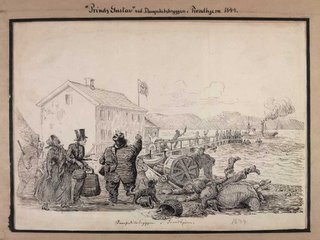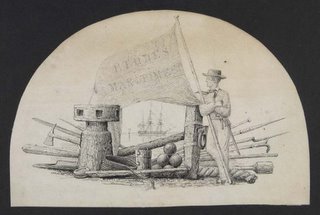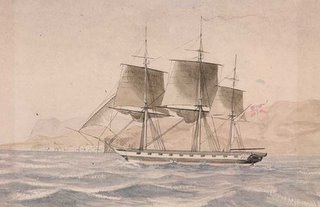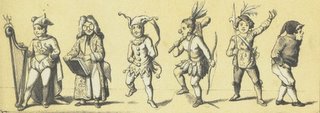
In victorian times, as the exotic parts of the world were being explored, orchids became incredibly popular as an emblem of a tropical paradise. There was something particularly romantic about the often arduous collection expeditions and warm faraway climes and inherent beauty of the flowers that ignited the passions of enthusiastic collectors.
John Day (1824-1888) was one of those ardent admirers and spent about 40 years cultivating them in his own glasshouses and searching them out on expeditions. He introduced many species into Britain for the first time (and many are named after him or in his honour). But Day is best remembered for the 53 scrapbooks containing about 3000 watercolour paintings of the objects of his passion. The illustrations were often accompanied by descriptive text from a botanical professor friend.
The Romance of Orchid Discovery: The John Day Scrapbooks at the Royal Botanic Gardens, Kew.
Wednesday, November 30, 2005
The Orchid Scrapbooks of John Day
Los Calaveras de Posada






José Guadalupe Posada (1852-1913) was a Mexican lithographer and engraver who produced some 20,000 illustrations during his life. He mostly worked out of a print shop in Mexico City where he engraved illustrations for newspapers but the majority of his work was published in the the broadsides of the pennypress, a favourite among the poorer people.
It is his satirical calaveras (colloquial for skeletons) that have achieved lasting fame. They have been adopted as a motif by (or indeed, arose from) the Mexican celebration - Día de los Muertos (Day of the Dead).
Just by the by, this festival derives from the ancient practises of the mesoamerican civilizations combined with the catholic All Saints Day and has no association with the more macabre Halloween. While the Posada images recall the 15th century european figures from Holbein in the Danse Macabre, I could find no evidence to suggest that this was a direct influence on Posada. The images here and the background to Día de los Muertos are certainly evidence for the calaveras being a generally 'happy' form of illustration.
Diego Rivera was a big fan of Posada and together with other art students, they would go to the print shop to collect the shaving from the Posada's engraving blocks. Rivera would immortalize Posada in the mural Sueño de una tarde dominical en la Alameda Central (Dream of a Sunday Afternoon in the Alameda).
It was the nature of the times in Mexico that critical publications were suppressed, which meant that the biting satire of illustrations such as those of Posada became all the more poignant. The political and social threads in the illustrations often require some local background however. Despite the important place Posada holds in the pantheon of Mexican (print) art, he was largely unknown and very poor at the time of his death - at the beginning of the Mexican revolution.
- José Guadalupe Posada The Man His Art His Times.
- The University of New Mexico eLibrary have a large collection of Posada images, mostly from broadsides. (subject list)
- Printmaker of the Dead - San Jose University Posada website.
- Diego Rivera Museum display. (Sueño de una tarde dominical en la Alameda Central)
- This site has reasonable reproductions of some calaveras.
- José Guadelupe Posada and the Corridos of the Mexican Revolution - a PhD excerpt.
- The Posada Museum -- a short review.
- Día de los Muertos - wikipedia.
- The Austin Chronicle exhibition review (not sure what year).
- Further Left Forum entry about Día de los Muertos.
- Día de los Muertos links - large set of links covering many subject areas, includes a number of Posada links.
- Und unten zerschellt das Gerippe - a recent entry by Suzanne G at Thee Temple ov Psychick Blah which, among other things, touches on Danse Macabre.
- José Guadalupe Posada - wikipedia.
- Addit: Someone pointed me to a recent Metafilter post which included this site on Día de los Muertos which has links to a lot of stuff in Mexico including photographs.
classic-that is, pre-Cortesian-art" says Diego Rivera when speaking of Posada.
"Another trait of Mexican classical art is its love of character."
Tuesday, November 29, 2005
Severini Pochoir



Gino Severini pochoir prints from 1930 at La Biblioteca Nazionale Centrale di Firenze.
Severini was a prominent futurist and here he applies a cubist approach to traditional Commedia dell'arte material. [previously pochoir]
David Rumsey Historical Maps




The above images come from: Atlas para el Viage de las Goletas Sutil y Mexicana 'al reconocimiento del Estrecho de Juan de Fuca en 1792', published in 1802 by the author José de Espinosa y Tello de Portugal.
[The portraits are very similar to those posted a few weeks ago from the Cook's Voyage to the Pacific set]
Publication note: The Spanish "Vancouver." Atlas volume only, first edition. Sometimes attributed to Dionisio Alcala Galiano. The title of the text volume is "Relacion del Viage Hecho por las Goletas Sutil y Mexicana en al ano 1792 para reconocer el estrecho de Fuca..." The last and very important voyage up the Pacific coast to be undertaken by Spain is detailed in the nine maps and eight plates of the atlas. Galiano and Cayetano Valdes led the expedition, arriving in the northwest at the same time as Vancouver. Although the maps were published four years after the Vancouver maps, Wagner considers them in many respects to be superior, and Humboldt used them in his Essai Politique sur le Royaume de la Nouvelle Espagne. Wagner further states: "The general impression today...is that the English discoveries of Vancouver were published four years before those of the Spaniards. This...is a misapprehension... The principal reason, however, why the nomenclature and geography of Vancouver came to occupy the field was that his maps were extensively copied by the famous English cartographer, Aaron Arrowsmith, and later by the English Admiralty." "


Picture of Nations or Perspective Sketch of the Course of Empire. Published 1836 in Atlas to accompany a System of universal history; containing, I. A chronological picture of nations, or perspective sketch of the course of empire. II. The progressive geography of the World, in a series of maps, adapted to the different epochas of the history. by the very interesting Emma C. (Hart) Willard, principal of Troy Female Seminary.
[I found this to be an extraordinary image and the detail here hardly does it justice. It was an attempt to outline world history from the time of creation, through the birth of Christ (the obvious star) up to the empire of Napoleon, being the horizontal section at bottom centre of the image. It reminds me of the tree branching cladogram maps in species phylogenetic relationships]


[The last 2 images I had collected along the way and didn't retrieve any information about them]
Click on the images here for slightly larger versions.
Serendipity was involved in my somehow finding my way (back) to the fantastic David Rumsey cartographic website.
Last month, another 1500-odd further maps were uploaded to bring the total of high resolution free maps available to over 12,000, out of a personal collection that totals about 150,000 maps.
It was among the new images that I spent way too much time today in collecting the above jpegs. As usual, I was drawn to curios and there are plenty of others that I didn't post. Of course, most of the material online is strictly maps and atlases and they concentrate on the Americas between 1700-1900 for the mostpart, but not exclusively. It will likely require downloading a browser plugin to see the large documents (I'd done so previously, so can't remember what's necessary - nothing too painful anyway)
This profile of David Rumsey is well worth a read. His is a great attitude for anyone who likes to see primary source material available free online.
I am obliged to the custodian of The Map Room both for pointing me towards the profile of Rumsey but more importantly, from a personal perspective, for announcing and linking BibliOdyssey when it began, for which I am very grateful. If you have any latent or overt cartophilic tendencies, go have a look at The Map Room. It's aimed at a general audience and is not too technical.
China Prints



China Prints - it is a slow server but worth the wait. Larger jpegs are also available. They have works by about 30 print artists.
"Gradually people realize no more arts can express the continuity of culture, the concern of the development of human beings and its future than prints. Facing the development of prints, we try to record all the outstanding printmakers. Their artworks reflect the enterprising spirit and taste of beauty of human beings."
[The printmaker, title and technique are in the above image URLs]
Monday, November 28, 2005
Artificial Magic











Editor, fellow Jesuit and assistant to the exceptional Athanasius Kircher, Kaspar Schott (1608-1666) also ranged in scientific territories with his mentor that bordered the illicit and forbidden world of magick. As one of a number of custodians of the renowned Musaeum Kircherianum, Schott was uniquely placed to elucidate upon the catalogue of fantastical machines of 'artifical magic' on display.
"Perhaps this very flirtation with the black arts was a source for titillation for the princely and religious audience of Kircher’s wonders – an audience directly involved in the persecution of popular magic during the same period – allowing them to experience the “armchair-thrills” of magic without being morally implicated. Jesuit theatrical productions during this period were particularly famous for their stage-machinery – convincing representations of hell were a speciality – and for their hard-hitting moral didacticism, both features that they shared with Kircher’s machinic-performances, as we have seen in the case of the Delphic oracle."In the preface to his 1657 treatise, Mechanica Hydraulico-Pneumatica, which is displayed in full at the Max Planck Institute's Archimides Project, Schott advises readers -
"There is, in the much-visited Museum (that we will soon publish in print) of the Most learned and truly famous Author mentioned above (i.e. Kircher), a great abundance of Hydraulic and Pneumatic Machines, that are beheld and admired with enormous delight of their souls by those Princes and literati who rush from all cities and parts of the world to see them, and who hungrily desire to know how they are made, and so that I can satisfy their desire to know the construction of the machines, I have undertaken to show the fabric, and almost the anatomy of all of the Machines in the said Museum, or already shown elsewhere by the same author."
- Between the Demonic and the Miraculous:Athanasius Kircher and the Baroque Culture of Machines, a long but thoroughly interesting essay by Michael Gorman at Stanford University.
- See also Giornale Nuovo entries about Kircher.
- The Galileo Project site on Kaspar (Gaspar) Schott.
[The Archimides Project site has a scaler arrangement preventing extraction of each image at full size, so most of the images here are taken from their zooming features. The 4th and 5th image above are details from the 3rd image]
Reilluminating the Bible
challenge (our Sistine Chapel), a daunting task."
 Since 1970, Donald Jackson (Senior Illuminator to the Queen of England’s Crown Office and an elected Fellow and past Chairman of the prestigious Society of Scribes and Illuminators) has expressed the desire to handwrite the bible and include illuminations. It would be the first undertaking of its kind since the invention of the printing press.
Since 1970, Donald Jackson (Senior Illuminator to the Queen of England’s Crown Office and an elected Fellow and past Chairman of the prestigious Society of Scribes and Illuminators) has expressed the desire to handwrite the bible and include illuminations. It would be the first undertaking of its kind since the invention of the printing press. It is appropriate that St Johns Benedictine Abbey, who have a 1500 year association with manuscripts (they still have significant holdings) should acquiesce to Jackson's wishes, and they formally commissioned the project in 1998/1999. Using calf vellum, handmade inks with quill and gilding and silver inlay work, Jackson began the monumental task with: "In the beginning was the word.." in March 2000.
It is appropriate that St Johns Benedictine Abbey, who have a 1500 year association with manuscripts (they still have significant holdings) should acquiesce to Jackson's wishes, and they formally commissioned the project in 1998/1999. Using calf vellum, handmade inks with quill and gilding and silver inlay work, Jackson began the monumental task with: "In the beginning was the word.." in March 2000. By May 2005, 4 of the 7 volumes had been completed. They measure some 16 x 25 inches and will number about 1100 pages when finished. There will be 160 illuminations whose content have been worked out by a team - "It is up to a committee of artists, medievalists, theologians, biblical scholars and art historians to create these theological stories for Donald Jackson, the artistic director of The Saint John’s Bible."
By May 2005, 4 of the 7 volumes had been completed. They measure some 16 x 25 inches and will number about 1100 pages when finished. There will be 160 illuminations whose content have been worked out by a team - "It is up to a committee of artists, medievalists, theologians, biblical scholars and art historians to create these theological stories for Donald Jackson, the artistic director of The Saint John’s Bible." They are not completely shunning modernity: "A computer is used to size text and define line breaks. These pages are laid out in full size spreads with sketches in position. Artists use these layouts to guide their work."
They are not completely shunning modernity: "A computer is used to size text and define line breaks. These pages are laid out in full size spreads with sketches in position. Artists use these layouts to guide their work."Astonishing. The Saint Johns Bible website have all the facts and media coverage and images of manuscript pages (with watermarks over larger jpegs) and you can even buy regular book copies of the completed volumes. [Thanks to Ars Theologica]
Norwegian Maritime Sketchbook








The hardest part (welllll...'one of', then) about perpetrating this entity called BibliOdyssey is casting off the imagery flotsam so that I'm not foisting too many digipixalities over the netowaves. I gave up this time. I spent absolutely ages sifting this 19th century scrapbook album. It is 75 webpages long with 2 album pages on each with about 1 to 6 individual sketches, paintings, newscuttings, and/or photos per album page. So there are a fair number of images in there. Not all of them are nautical in nature.
As best as I can understand given the (absolutely) appalling translations -- Langenburg, I am looking at you -- a few generations of the Diriks family contributed to this album over what must be about 80 years (I saw dates ranging from 1830 to 1865, but not everything is dated and there are obviously more recent items). Most of the artistry was undertaken in Norway, but there are works done in England, France, Germany and America among other places. And while I'm very unsure if they contributed to this book in any way, there is mention of Picasso, Munch and Modigliani as being family friends of the Diriks.
The Diriksfamiliens utklippsbøker is online at the National Library of Norway. Click on individual works for enlargements. There is no english.
Sunday, November 27, 2005
Diefenbach's Carnival







These fabulous illustrations appear in the 1873 children's poetry book Prinz Carneval der Jüngere ('Prince Carneval the Younger') which is online at the Braunschweig University Digital Library - it's only about 23 pages long. Braunschweig U. Library really have a fine digital book set, particularly for children and I shall be fossicking there again in the future for sure.
The verses which appear below the Leonard Diefenbach ?lithographs were composed by Carl von Prenzlau. I saw Diefenbach's name associated with a couple of other children's book while searching around but I couldn't find anything in the way of background material. The strips of characters above remind me a little of Joseph Strutt whose work predates Prinz Carneval by some 80 or so years. But Diefenbach's illustrations are just excellent by my thinking and are best seen full size on the Library's website - translation page.


























































